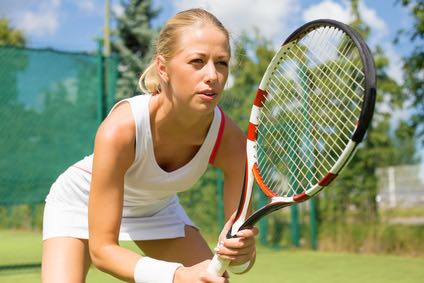Wimbledon is around the corner so dust off the tennis racquets, but beware of tennis elbow!
Tennis elbow is a painful condition that is characterised by localised pain over the bony prominence on the outside of the elbow. It is caused by a strain to tendons of the extensors muscles of the wrist (extensor carpi radialis). Pain is aggravated with gripping and twisting the forearm.
Golfer’s elbow is the same form of injury affecting the flexor tendons and therefore is painful on the bony prominence on the inside of the elbow.
It is not only tennis that causes this condition but any activity that requires repetitive gripping and twisting of the forearm such as painting and decorating.
Tennis injuries: treatment of tennis elbow
Collateral tissue damage can be minimised by following the POLICE or PRICE guidelines which stands for:
- Protection: modifying activity, taping and splints
- Optimal Loading or Rest: Optimal loading means replacing rest with a balanced and incremental rehabilitation programme where early activity encourages early recovery.
- Ice: Cold compress or cold water immersion
- Compression: strapping and compression bandage
- Elevation: the injured part, here the elbow is placed higher than the heart
Painkillers such as paracetamol can ease pain.
Anti-inflammatories may not be recommended in the first 5-7 days after injury as this can slow down the healing process.
Physiotherapy for tennis elbow
If your pain does not settle within 2 weeks, see a physiotherapist for an accurate diagnosis and treatment and to ensure there is no cervical or neural cause for the pain.
As tennis elbow is an overuse injury it is important to identify and address the roots of the problem.
A physiotherapist will perform a thorough assessment to evaluate the function of the muscles and joints.
Biomechanical assessment tests will identify the underlying causes of your injury such as faulty movement patterns, asymmetry, muscle imbalance, lack of coordination and balance.
Physiotherapy rehabilitation from the early phase to return to play is important to avoid a long period off play and prevent reoccurrence.
We use a variety of techniques or a combination of tennis-specific prescribed exercises, manual therapy, ultrasound, acupuncture and advice. We may recommend an epicondylitis clasp.
Most importantly we will help you understand the problem.
If your tennis elbow does not respond to physiotherapy, you may be referred to a specialist for a steroid injection.
When tennis is the cause of tennis elbow, the following factors need to be considered:
- The movement patterns and posture of the individual
- The grip position
- The handle or grip size
- A change in stroke
- A different court surface
- A different racquet string tension
- An increased intensity of play
- Irregular play or practice
- Poor warm up and cool down
Prevention of tennis elbow
Ensure that you have a good technique and check that you have the correct grip size and string tension. Always warm up and stretch and after a break from playing, make sure you get back into it gradually and then keep up a regular level of play.








